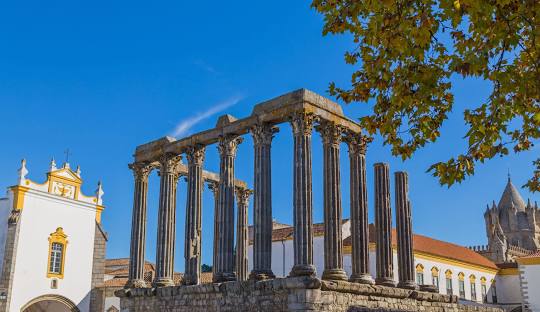Evora, Portugal
🏛️ Évora, Portugal: A Living Museum in the Alentejo Heartland
Évora is a UNESCO World Heritage city that wears its 2,000-year-old history with elegance and pride. Located in the sun-baked Alentejo region of Portugal, this walled city is a place where Roman temples, Gothic cathedrals, and whitewashed houses co-exist harmoniously. Often overlooked by travelers heading to Lisbon or the Algarve, Évora offers a quieter, more soulful experience, full of rich flavors, architectural marvels, and timeless ambiance.
🏺 Time-Travel Through Évora’s History
-
Templo Romano (Roman Temple of Évora): Also called the Temple of Diana, this well-preserved Roman ruin dates back to the 1st century and stands as an iconic symbol of the city.
-
Évora Cathedral (Sé de Évora): A massive granite cathedral blending Romanesque and Gothic styles—climb to the rooftop for sweeping views of the Alentejo plains.
-
Capela dos Ossos (Chapel of Bones): One of Évora’s most haunting sights, this small chapel is decorated with the skulls and bones of over 5,000 monks, meant to remind visitors of the brevity of life.
-
Aqueduto da Água de Prata: A 16th-century aqueduct that still stands tall; walk along its path to discover how it weaves through the modern city.
Every stone in Évora tells a story—of Romans, Moors, monks, and kings who have shaped the city over millennia.
🎨 Culture in Every Corner
-
Museu de Évora: Located near the cathedral, this museum houses everything from Renaissance paintings to ancient Roman relics.
-
University of Évora: One of the oldest universities in Portugal, founded in 1559. Its cloisters and lecture halls are beautifully preserved and worth a visit.
-
Local Artisans: Pottery, cork goods, and azulejos (ceramic tiles) are everywhere in Évora—visit Oficina da Terra to see crafts made by local hands.
Évora is as much about quiet cultural encounters as grand architectural wonders.
🍷 Flavors of Alentejo: Food & Wine
-
Dom Joaquim: A local favorite serving hearty Alentejo cuisine, including pork with clams and migas (bread-based stuffing).
-
Taberna Típica Quarta-Feira: Known for its rustic, fixed-menu meals that feel more like a family dinner than a restaurant.
-
Fialho: One of Évora’s best-known restaurants, where traditional dishes like açorda de alho (garlic bread soup) shine.
-
Cartuxa Winery: Just outside the city, this legendary winery offers tastings of Alentejo wines, which are bold, earthy, and full-bodied.
Pair your meal with a glass of local red and you'll understand why Évora is a gastronomic gem.
🛏️ Where to Stay in Évora
-
Luxury:
-
Convento do Espinheiro: A 15th-century monastery turned five-star hotel with a spa and vineyards.
-
-
Mid-Range:
-
Albergaria do Calvário: An eco-conscious boutique hotel set in an olive oil mill.
-
-
Budget:
-
StayÉvora: A cozy, affordable guesthouse inside the old walls with modern comforts.
-
Wherever you stay, expect warm hospitality and an atmosphere steeped in calm.
🚶 What to Do & See Beyond the Walls
-
Almendres Cromlech: A short drive from Évora, this Neolithic stone circle predates Stonehenge and is one of Europe’s largest megalithic monuments.
-
Giraldo Square (Praça do Giraldo): The beating heart of the city with arcaded buildings, fountains, cafes, and plenty of people-watching.
-
Jardim Público: A lovely place to stroll, especially during golden hour when the light softens the city’s golden stone.
Évora’s magic lies not in rushing but in wandering slowly, soaking in the light, and listening to the whispers of the past.
💡 Travel Tips for Évora
-
Getting There: About 1.5 hours by car or bus from Lisbon. A train is also available but less frequent.
-
Best Time to Visit: Spring (April–June) or autumn (September–October). Summer can be extremely hot.
-
Language: Portuguese, but English is commonly spoken in hotels and restaurants.
-
Currency: Euro (€)
-
Local Insight: Shops close mid-afternoon for siesta—plan accordingly.
📸 Top Instagram Spots in Évora
-
Sunlight hitting the columns of the Roman Temple at dusk 🏛️
-
Inside the Chapel of Bones 💀
-
Rooftop views from Sé de Évora 📸
-
A glass of red wine at a Cartuxa vineyard 🍷
-
The arcades of Praça do Giraldo☕


